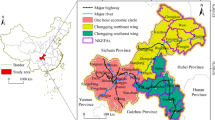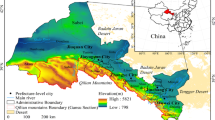Abstract
This paper, taking Beiwenquan Town of Beibei, Chongqing as an example, assessed the impacts of land use on ecological health by comprehensive index method, and discussed methodological system of sustainable land use planning based on ecological health. Results indicated that: 1) From 1992 to 2002, land use changes focused on 12 patterns with the total conversion area of 92.11%, which were related to cultivated land, residential and industrial-mining area, and orchard land. Urbanization and economic reconstruction with the leading driving forces. 2) There was obvious difference of the areas of ecotypes driven by land use change in wide valley and mild slope between 1992 and 2002, while there were little or no difference in steep slope and very steep slope. 3) Both of the conditions of ecological health in 1992 and 2002 were sound, and the ecotypes focused on the types of health and sub-health. But, health ecosystem in 1992, with an area of 764.64ha, accounting for 38.51% of the total evaluation area, was better than that in 2002, with an area of 636.10ha, accounting for 34.19% of the total evaluation area. 4) The ecotypes involved into different ranges have already degenerated, due to humankind’s disturbance, while the conditions of ecological health in the same range in 1992, regardless of stability and reconstruction, were better than that in 2002. 5) The planning scenario based on ecological health was accorded with the practice condition of Beiwenquan Town: 388.29ha of cultivated land could meet the Beiwenquan demand of food and byproduct; 1045.26ha of forest land area, the Beiwenquan demand of ecological health; and 1004.73ha of the residential and industrial-mining area, the Beiwenquan building demand. 6) Sustainable land use planning based on ecological health had higher useful value, because it not only stood to ecological theory, but also satisfied the development demand of society and economy.
Similar content being viewed by others
References
AERTS J C J H, EISINGER E, HEUVELINK G B M et al., 2003. Using linear integer programming for multi-site land-use allocation [J]. Geographical Analysis, 35(2): 148–169.
ARBEL A, KORHONEN P, 1998. Using objective values to start multiple objective linear programming algorithm [R]. Interim Report. Vienna: International Institute for Applied Systems Analysis.
BURGER J, GOCHFELD M, 2001. On developing bioindicators for human and ecological health [J]. Environmental Monitoring and Assessment, 66: 23–46.
Chongqing Statistical Bureau, 2003. Chongqing Statistical Yearbook[R]. Beijing: China Statistics Press. (in Chinese)
COSTANZA R, NORTON G B, HASKELL B D, 1992. Ecosystem Health: New Goals Environment Management[M]. Washington, DC: Island Press.
CRAWFORD D W, BONNEVIE N L, GILLIS C A, 1994. Historical changes in the ecological health of the Newark Bay Estuary New Jersey [J]. Ecotoxicol. Environ. Saf., 29(3): 276–303.
DANNENBERG A L, JACKSON R J, FRUMKIN H et al., 2003. The impact of community design and land-use choices on public health: a scientific research agenda [J]. Public Health Matters, 93(9): 1500–1508.
DIBARI J N, 2003. Scaling exponents and rank-size distributions as indicators of landscape character and change [J]. Ecological Indicators, 3(4): 275–284.
DOUGLAS A S, ALLEN H, DAVID M et al., 2004. Remote sensing of vegetation and land-cover change in Arctic Tundra Ecosystems [J]. Remote Sensing of Environment, 89(3): 281–308.
ERICH T, ULRIKE T, 2002. Impact of land use changes on mountain vegetation [J]. Applied Vegetation Science, 5: 173–184.
FABOS I G, 1981. Regional ecosystem assessment: an aid ecologically compatible land use planning [A]. In: Perspectives of Landscape Ecology [C]. Wageningen.
FAIRWEATHER P G, 1999. State of environmental indicators of river health exploring the metaphor [J]. Freshwater Biology, 41: 211–220.
FU Bo-jie, LIU Shi-liang, MA Ke-ming, 2001. The contents and methods of integrated ecosystem assessment (IEA) [J]. Acta Ecologica Sinica, 21(11): 1885–1892. (in Chinese)
GAO Fang-li, CAO Xiao-lin, YANG Ding-zhong et al., 2003. Comprehensive regionalization of natural disasters in Chongqing City as revealed by GIS [J]. Resources and Environment in the Yangtze Basin, 12(5): 485–490. (in Chinese)
GLADE T, 2003. Landslide occurrence as a response to land use change: a review of evidence from New Zealand [J]. Catena, 51(3–4): 297–314.
JING Gui-he, 1991. The landscape ecological reconstruction in some degraded land in Northeast China [J]. Acta Geographica Sinica, 46(1): 8–14. (in Chinese)
JONES O A H, VOULVOULIS N, LESTER J N, 2004. Potential ecological and human health risk associated with the presence of pharmaceutically active compounds in the aquatic environment [J]. Critical Reviews in Toxicology, 34(4): 335–350.
LI Chun-ying, LIU Cai, CHEN Yan, 2003. One of the hotpoints for modern ecology research: ecosystem health [J]. Journal of Northeast Forestry University, 31(4): 54–55. (in Chinese)
LIANG Wen-ju, WU Zhi-jie, WEN Da-zhong, 2002. Research directions of agroecosy stem in the early 21st century [J]. Chinese Journal of Applied Ecology, 13(8): 1022–1026. (in Chinese)
LIU Hui-qing, XU Jia-wei, WU Xiu-qin, 2003. Health assessment of ecosystems Nêdong County of Tibet [J]. Scientia Geographica Sinica, 23(3): 366–371. (in Chinese)
LOUISA J M J, ANTONIO D G, 2003. Land-use data collection using the "land cover classification system": results froma case study in Kenya [J]. Land Use Policy, 20(2): 131–148.
MARIO S, JOAO A C, 2003. Development of a stochastic dynamic model for ecological indicators’ prediction in changed Mediterranean agroecosystems of north-eastern Portugal [J]. Ecological Indicators, 3(4): 285–303.
MCHARGE I L, 1969. Design with Nature [M]. New York: Natural History Press.
NAVEH Z, 2001. What is holistic lanscape ecology? A conceptual introduction [J]. Landscape and Urban Planning, 50(1–3): 7–26.
NAVEH Z, LIEBERMAN A S, 1984. Landscape Ecology: Theory and Application [M]. New York: Springer-Verlag.
ODELL E A, THEOBALD D M, KNIGHT R L, 2003. Incorporating ecology into land use planning: the songbirds’ case for clustered development [J]. Winter, 66(1): 72–82.
OLGERTS N, SIMON B, INETA G et al., 2005. The impact of economic, social and political factors on the landscape structure of the Vidzeme Uplands in Latvia [J]. Landscape and Urban Planning, 70(1–2): 57–67.
PARKES M, PANELLI R, 2001. Integrating catchment ecosystems and community health: the value of participatory action research [J]. Ecosystem Health, 7(2): 85–106.
Problem Group of Northeast Normal University, 1990. The Landscape Ecological Construction of Land Desertification in Midwest Jilin Province [M]. Changchun: Northeast Normal University Press. (in Chinese)
SHAO Jing-an, LIU Xiu-hua, 2002. Advanced thought on defarming and reafforestation in Chongqing—joined with development of the tourist resources [J]. Problems of Froestry Economics, 22(2): 85–88. (in Chinese)
SHRESTHA R P, 2004. Developing indicators for assessing land-use sustainability in a tropical agro-ecosystem: the case of Sakaekrang watershed [J]. Thailand. Int. J. Sustain. Dev. World Ecol., 11: 86–98.
THEOBALD D M, HOBBS N T, 2002. A framework for evaluating land use planning alternatives: protecting biodiversity on private land [J/OL]. Conservation Ecology, 6(1): 5.
THEOBALD D M, HOBBS N T, BEARLY T, 2000. Incorporating biological information in local land-use decision making: designing a system for conservation planning [J]. Landscape Ecology, 15: 35–45.
TOEWS D W, KAY J, GITAU C N, 2003. Perspective changes everthing: managing ecosystems from the inside out [J]. Frontiers in Ecology and the Environment, 1(1): 23–30.
WANG Wan-mao, LI Zhi-guo, 2001. The exploration on the ecological preservation planning of arable land [J]. Chinese Journal of Eco-Agriculture, 9(4): 54–57. (in Chinese)
WILCOX B, 2001. Ecosystem Health in practice: emerging areas of application in environment and human health [J]. Ecosystem Health, 7(4): 318–325.
XIAO Feng-jin, OUYANG Hua, 2002. Ecosystem health and its evolution indicator and method [J]. Journal of Natural Resources, 17(2): 203–209. (in Chinese)
YANG Zi-sheng, 1996. A Study on Dynamics and Optimization of Agricultural Landscape Pattern in Nujiang Canyon Area [M]. Kunming: Yunnan University Press. (in Chinese)
YANG Zi-sheng, 2000. The discussion for land ecology [J]. China Land Science, 14(2): 38–43. (in Chinese)
ZHOU Bing-zhong, CHEN Fu, BAO Hao-sheng et al., 2002. Land use classification in Yangtze River Delta [J]. Resources Science, 24(2): 88–92. (in Chinese)
ZHU De-ju, 1995. An Introduction to Land Science [M]. Beijing: Chinese Agricultural Science and Technology Press. (in Chinese)
Author information
Authors and Affiliations
Corresponding author
Additional information
Foundation item: Under the auspices of the Key Project of Science and Technology of the Ministry of Education (No. 03111) and Incubation Fund Project of Science and Technology Committee of Chongqing (No. 017079)
Biography: SHAO Jing-an (1976-), male, a native of Bozhou of Anhui Province, Ph.D., specialized in land use and eco-environmental evolution. E-mail: shaojinganswau@yahoo.com.cn
Rights and permissions
About this article
Cite this article
Shao, Ja., Wei, Cf. & Xie, Dt. Sustainable land use planning based on ecological health. Chin. Geograph.Sc. 15, 137–144 (2005). https://doi.org/10.1007/s11769-005-0006-x
Received:
Issue Date:
DOI: https://doi.org/10.1007/s11769-005-0006-x




